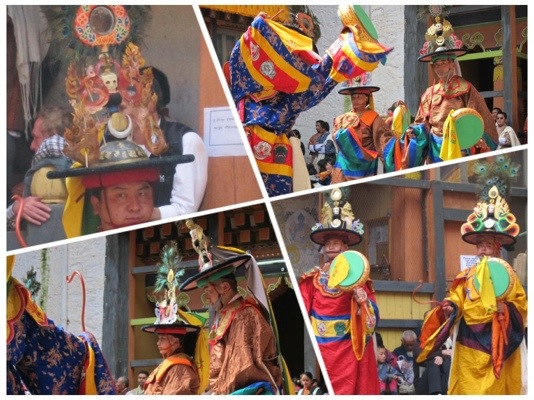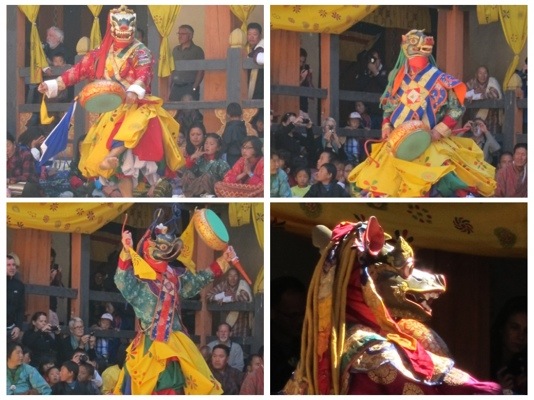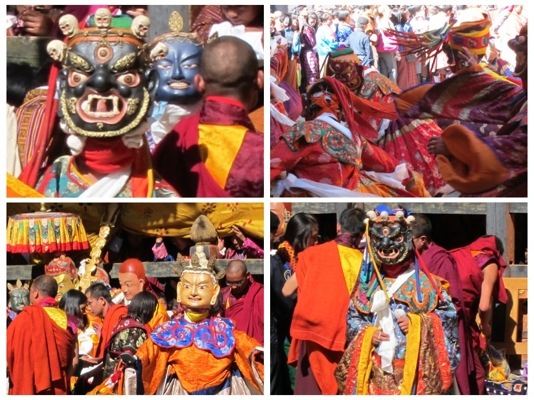The Jakar Tshechu, A Masked Dance Festival In Bumthang, Bhutan
Like every city in Bhutan, Jakar has a beautiful Dzong (a Fortress) located high on a hill.
Jakar Dzong means the ‘Fortress of the White Bird,’ and it was constructed in 1667.
It was rebuilt again after being severely damaged in the great earthquake of 1897.
Some say that a group of high Lamas (spiritual teachers) were searching for a suitable site for the new Dzong, when they noticed that a large white bird continuously circled over the top of that hill.
The Lamas considered this to be a good omen, and the hill was selected as the site for the Dzong and the White Bird was adopted as its name.
Others say that the Lamas witnessed a group of four large white birds, who took off in all four directions, which was an oddity and a good omen, since birds usually fly in a flock and in the same direction.
We made it up the steep hill to the entrance of the Dzong, to attend a sacred Tshechu (literally “Day Ten”) festival.
The Tshechu is held on the tenth day of a specific month in the lunar Tibetan calendar, which roughly falls in the month of October.
People came from all over the valley, wearing their best traditional clothing.
Old ladies in beautiful Kira dresses, walked slowly up the steep steps, holding the hands of their great grandchildren, or carried a large thermos filled with their packed lunch.
Mothers and grandmothers climbed up with babies tied to their backs, and fathers and grandfathers carried toddlers and blankets or pieces of flat cardboard to sit on.
The tourists carried huge cameras with interchangeable lenses.
The Tshechu is a series of masked dances which are conducted by the monks.
Between the masked dances there are folk dances performed by lay people in traditional clothing.
As the Folk dancers made their elegant movements and hand gestures, women with beautiful voices sang about the beauty of Bhutan’s villages, about vast valleys, about deities who reside in high mountains, and about the Black necked cranes, who come to the land every winter from Tibet.
As with every myth and tale, one thing you will not find is consistency.
The versions are as widely different as the people telling them.
So do the exact origin and the meaning of the dances, all are clouded with mist.
Some say that Guru Rinpoche in the eighth century had a vision of the dances and the exact movements of how the dances were to be performed.
He visited Bhutan at the request of the dying king Sindhu Raja.
Guru Rinpoche, (also known as Padmasambhava) performed a series of rituals and a few of those dances in the Bumthang valley to ward off evil spirits and to restore the health of the king.
The healed king was so grateful, that he later helped spread Buddhism in Bhutan.
Padmasambhava organized the first tsechu in Bumthang, where he presented his eight manifestations and other dances that he saw in his vision.
Some say that the treasure discoverer (Treton) Karma Lingpa originated the Rakshas dance, to portray the Bardo state after death…
Since then, those dances have been performed according to precise instructions transferred to and learned by past Buddhist masters.
The dances convey the afterlife, the Bardo, and all the mythical or mind-created creatures that one might encounter after death.
It is said that in the Bardo state, one will view all of the merits and kindnesses that one experienced in life, and all the misjudgments, ignorance, anger and mistakes that one did, and that those will determine one’s next incarnation.
It is believed that witnessing the masked dances will better prepare people to handle the unknown, which they will encounter after death.
Viewing all the terrifying creatures and masks will prepare people to all possible eventualities of meeting terrifying demons that their minds, which were recently released from the confinement of the body, can conjure up.
It is also believe that watching the masked dances, which are accompanied with strong instrumental music, leaves an indelible imprint on the mind stream and consciousness.
This imprint will produce a corresponding result in the future, and viewing the dances that are imbued with sacred symbolism, is considered to be a very auspicious experience and a sanctifying meritorious act.
The cobbled courtyard of the Dzong was surrounded with people, and it was hard to find a place to sit or even to stand, to view the dances.
I felt happy that we attended all the three major days of the festival, and earlier got a chance to see some of the dances and the masks, before the place got too packed with people.
I noticed that the Bhutanese people have a VERY different concept of personal space than the tourists.
When a Bhutanese man noticed that I was trying to photograph the dance above his head, he gave me his prime viewing space.
Within fifteen minutes, I had a whole group of young Bhutanese women linking their arms in mine, pressing against me, or shading me from the sun.
Their kids stood between my legs and in front of me, or poked their heads through every available space between the adults.
It felt natural and warm….
On the other hand, when later Jules signaled to me to come and sit next to him in a narrow space that he had found on a step, the tourist next to him got angry when I tried to squeeze between them, and said: “Hey do you mind?….”
Later on another day, when I had found a place to view the dances by the front row, another tourist stood next to me.
A young Bhutanese women squeezed between us.
The tourist looked absolutely horrified, as if he were being physically assaulted, while I squeezed over to make some room for her beside me.
She did not even seem to understand that she was doing something that had offended him, and that she was encroaching on “his personal space”….
The Bhutanese do not feel the same about space….
Space, like air, is meant to be shared by natural decree….
It is NOT to be claimed by anyone just because he had stood there first.
The enjoyment of EVERYONE is important to all… And so if you are there, they try to make it easier for you to see so you could ENJOY….
Wealthy and well-traveled tourists come to Bhutan from all over the world.
They buy the beautifully woven clothing, the Kira for women and the Gho for men.
They adorn themselves with the traditional scarves, but they take in SO LITTLE of the REAL customs and beauty of the people.
There is much merriment and happiness as the dances are performed.
The Buddhist religion is taken seriously and with much devotion, but not without humor and personal interpretation.
The festival holds much significance in the lives of local Bhutanese people, and it is an opportunity to meet with neighbors, see old friends, and share gossip.
The dances were most impressive.
They are called the Cham Dances, and there is exact symbolism to every tool held in the hands of the dancers, to the music and to the costumes, movements and masks.
We witnessed an elaborate dance where a body of a corpse (made of plastic) was laid on the ground, and the lord of cremation, (or the god of death,) along with dancers masked with animal heads, danced around it.
This is a list of the masked dances performed in the festival.
There were also folk dances in between the masked dances:
Dance of the Four Stags (Sha Tsam)
Dance of the Three kinds of Ging (Dri Ging Cham)
Dance of the fate (Damtsik Nguellen Cham)
Dance of the wrathful (Nga Ging Cham)
Dance of the Stags and Hounds (Shawo Shachi)
Dance of the 21 black hats with drums (Sha nga ngacham),
(Each black hat was tall and sprouted human skull, feathers, and mirrors.)
Dance of the Noblemen and the Ladies (Pholeg Moleg),
Dance of the Drums from Dramitse (Dramitse Ngacham)
Dance of the Lords of Cremation Grounds (Durdag)
Dance of the sixteen fairies (Ringa chudrug and nagchu cham)
Dance of the Terrifying Deities (Tungam)
Dance of the Rakshas and the Judgement of the Dead (Ragsha Mangcham)
The dances and the music were visually striking and very captivating.
The dancers seemed to be in a trance, and swirled like dervishes for a long time.
They were a bit disoriented and were assisted by fellow monks, as they left the main courtyard one by one.
On the last day, the whole congregation of people lined up to get blessed by the dancers who dressed up like Pema Lingpa, the Buddha and Guru Rinpoche.
They passed in a very long procession and bowed to get blessed before the Guru, who sat on a large throne.
On the very last day, before sunrise, there is the unfurling of the Thongdrel, a very large scroll painting (or thangka,) which is revealed only ONCE per year.
This painting measure 30 meters (98 ft) by 45 meters (148 ft) and has the image of Guru Rinpoche Padmasambhava at the centre, surrounded by his two consorts and his eight incarnations.
The scroll painting is revealed upon sunrise and is rolled up early in the morning.
It will be displayed again only a year later.
In some Dzongs around Bhutan, the scroll is a tapestry.
Masked Dances are a phenomenal experience to watch, but one must remember that they are imbued with symbolism, and that beyond the oral, visual and written traditions, there is a personal responsibility as to how to interpret the morals.
I will end with a quote from my favorite Buddhist master, Shabkar, who summed it up:
“In the beginning, I took the teacher as my teacher
In the middle, I took the scripture as my teacher
In the end, I took my own mind as my teacher….”










































